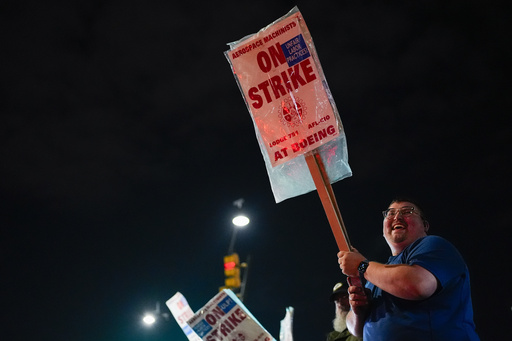
Since initiating a strike last month, Boeing employees have consistently expressed a core demand from their picket lines: the restoration of their pensions.
In 2013, Boeing made the controversial decision to freeze its traditional pension plan after negotiations with union members who narrowly agreed to concessions in exchange for keeping the production of the company’s aircraft in the Seattle region.
At that time, the aerospace giant argued that escalating pension obligations posed a threat to Boeing’s long-term fiscal health. However, this decision has led to significant financial repercussions for the company.
The International Association of Machinists and Aerospace Workers declared last Wednesday night that 64% of its members at Boeing voted against the company’s latest contract proposal, which included a notable wage increase of 35% over four years. A crucial point for the union members was the absence of a proposal from Boeing to reinstate pensions for the 33,000 machinists employed.
The continuation of the strike, now in its sixth week, further escalates Boeing’s financial woes, as the company is already grappling with substantial debt and reported a loss of $6.2 billion in the third quarter.
The strike has halted production of Boeing’s 737, 767, and 777 aircraft, significantly curtailing a vital revenue stream derived from the delivery of new planes to airline customers.
In response, Boeing indicated on Thursday that reviving pensions would not be an option in future discussions, a sentiment echoed by union members.
“I’m concerned for the younger generation,” remarked Charles Fromong, a tool-repair technician with 38 years at Boeing, at a Seattle union hall following the vote. “I’m nearing retirement, but they deserve a pension, and I deserve a raise.”
Understanding traditional pensions is essential. These plans provide retirees with a fixed monthly income for life, determined by factors like years of service and salary.
In recent decades, however, traditional pensions have been largely replaced by retirement savings accounts like 401(k) plans. In this model, workers contribute funds alongside employer contributions, relying on investments such as stocks and bonds to grow their retirement savings.
This shift has been significant; only 10% of private-sector workers now have pension plans compared to about 40% in the 1980s, according to Jake Rosenfeld, a sociology chairman at Washington University-St. Louis.
Employers have moved away from pensions as they pose financial risks and challenges in managing guaranteed retirement benefits, with defined contribution plans transferring that risk to employees and retirees.
Despite this trend, Rosenfeld expressed surprise that the issue of pensions remains a significant sticking point for Boeing employees.
In 2014, Boeing sought to eliminate its pension plan, threatening to relocate production of the 777 model if the union did not comply. Union leaders feared that nonunion workers would take over the jobs, as seen with the 787 Dreamliner production in South Carolina.
Ultimately, a slim 51% majority of machinists agreed to the deal, which involved Boeing contributing a percentage of wages to retirement accounts instead of funding a pension. Just two months later, Boeing also froze pension plans for 68,000 nonunion employees, including managers.
Currently, Boeing has consistently raised wage proposals but has stood firm against the return of pension plans. They have stated that there are no scenarios under which a defined-benefit pension would be reinstated due to the prohibitive costs associated with such plans.
Boeing noted that 42% of its machinists have been with the company long enough to qualify for the pension plan, albeit with benefits that have been frozen for years. The rejected contract included a proposal to raise monthly payouts for those affected from $95 to $105 per year of service.
According to a securities filing, Boeing’s accrued pension liability was assessed at $6.1 billion as of September 30.
Jon Holden, president of IAM District 751 representing the striking workers, stated that if the pensions cannot be restored, they need to negotiate other forms of compensation.
Although it is rare for companies to reinstate pension plans once frozen, a few exceptions exist. IBM reinstated its contributions to a defined-benefit plan this year in a bid to attract talent. Nevertheless, IBM’s decision came after its pension plan became overfunded following two decades of freezing.
Companies might reconsider pension plans if their financial health is favorable. A study indicated that of the largest corporate defined-benefit plans in the U.S., many were either fully funded or held surplus assets due to profitable investments and favorable interest rates.
Growing pressure is mounting on Boeing’s new CEO Kelly Ortberg to end the strike. Since it commenced on September 13, the company has laid off approximately 17,000 employees and is exploring methods to raise additional funds.
Bank of America analysts project that Boeing could be losing around $50 million daily during the strike. Should it continue for 58 days, akin to previous strikes, total losses might approach $3 billion.
The analysts suggest that improving the offer to the union could lead to a quicker resolution, noting that the long-term benefits of a generous agreement might outweigh the financial strain caused by a protracted strike.
